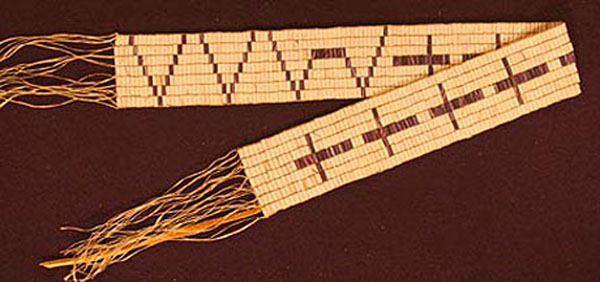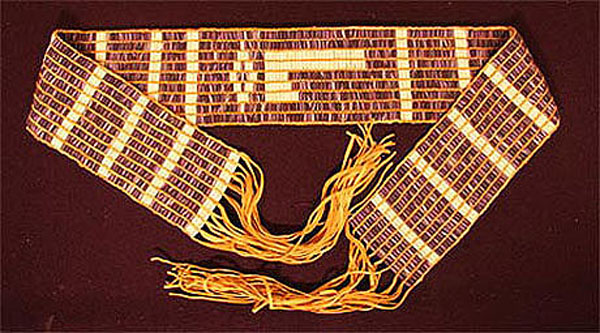Photographs (left to right): All Mohave Desert, California/Nevada
Wampum Belt Archive
Mohawk Wolf Belt
Original: Repatriated 2010
Reproduction: R. D. Hamell
June 06 2003
Original Size: |
Length, 32.5 inches. Width: 4.4. Rows: 14 wide. |
Reproduction: |
Beaded length: 45.0 inches. Width: 7.0 inches. Total length with fringe: 69.0 inches. |
Beads: |
Rows: 252 by 14 beads wide. Total: 3,528 beads. |
Materials: |
Warp: Leather. Weave: Artificial Sinew. |
Description:
This is a pictographic National Belt of the Mohawks. In the center are two human figures joined by clasped hands. Near and facing each end is the effigy of a wolf and at the ends are seven short purple horizontal stripes which alternate with seven white stripes. These stripes are practically eliminated at one end by partial mutilation. The belt is made on buckskin thongs.
The seven purple stripes, according to Mrs. Harriet M. Converse, represent seven nations. The central figures denote friendly relationship between the white man and Indian; the white beaded background indicates peace, while the wolves are an insinuation of guardianship of this peace and friendship. It has been mentioned that wolves symbolize the keepers of the east and west door of the Long I-louse, but Beauchamp infers some doubt as to this by taking issue with John Buck's statement that "the hereditary keeper of the eastern door of the Long House was a wolf."
Beauchamp (1901) defined it as a treaty belt between the French and the Mohawks. "The center figures—two men—represent the king and an Indian clasping hands in friendship. The seven purple lines signify seven nations, white the peace paths guarded at each end, east and west, by sachems of the Wolf clan, symbolized by the purple animal figures. The hereditary keeper of the Long House was a Wolf, the Do-ga-e-o-ga of the Mohawks according to John Buck. The Do-ne-ho-ga-weh of the western door was also a Wolf.” The Mohawk chief mentioned was a Turtle, but the Seneca chief is correct. The Mohawks treated with the French, but were never in their alliance, and the emblems are those of the middle of the 18th century. At that time the western Iroquois were balancing between the English and the French" (Beauchamp 1901: 427).
Bonaparte (2005) stated he did not have an "explanation for why the English figure became a French one in this description. Perhaps Mrs. Converse didn't fully trust what was told to her, and sought another explanation from other Iroquois informants such as John Buck. She may have not had access to Margaret Cook, as she does not actually specify who she purchased the belt from in St. Regis. Her research into the clan of the “doorkeepers” may have been to bolster the belt’s monetary and historical value to the New York State Museum, which was avidly collecting Iroquois belts at the time. Elements of the Beauchamp/Converse description later ended up in Ray Fadden’s book on wampum, which served to solidify its identity as the “wolf belt” in the minds of Akwesasronon ever since."
'St Regis-Caughnawaga, 'Bury the Hatchet" Belt, and this belt have been associated with the Great Peace Council held at Kahnawake in Montreal ending the French and Indian War ca 1760. (Bonaparte, 2012).
 |
 |
References:
Beauchamp, William. 1901. Wampum and Shell Articles Used by the New York State Indians. NYS Mus. Bulletin.
Bonaparte, Darren: 2005. As Long As Water Runs, Skies Do Shine, And Night Brings Rest - The Covenant Chain of Peace and Friendship Returns to Akwesasne. http://www.wampumchronicles.com/wolfbelt.html
Bonaparte, Darren. 2012. Personal Communications.Also see WampumChronciles: http://www.wampumchronicles.com/
Clarke, Noah, 1931. The Wampum Belt Collection of the New York State Museum. Bulletin 288, Fig. 37.
 |
 |
 |
 |
 |
 |
 |
 |
|---|

